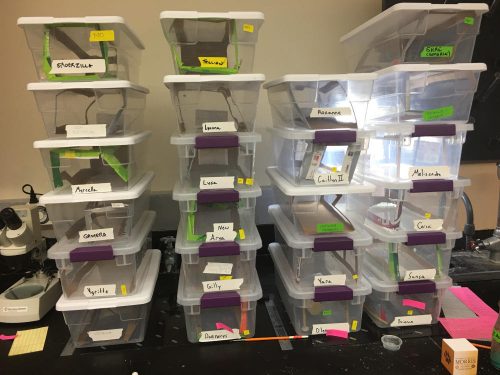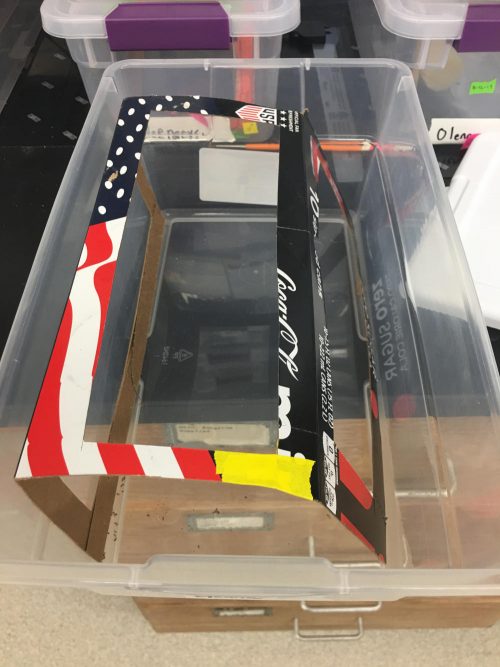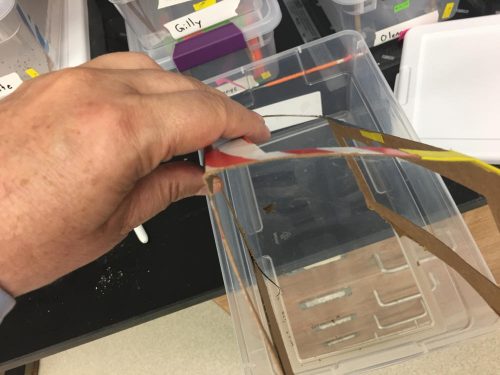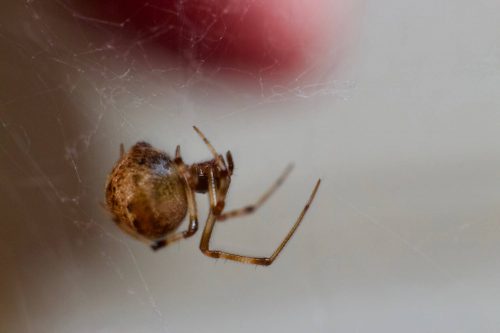One of the benefits of my job is that I get to work with young men and women all day, except when I’m not, when I’m puttering about with spiders (we will pretend committee meetings do not happen). So this morning I had my coffee and then toddled off to the lab to tend to my little friends.
Here’s my breeding colony.
They’re the ones with special privileges. They get the big roomy 5.7L sterilite containers, with one female per cage and connubial visitations. There are also racks in a pair of incubators with about 50 more spiders living in 3cm diameter tubes; they seem content, as long as food keeps getting delivered. So some of the spiders get to live in a suite at the Hilton, others are in the capsule hotel.
The larger cages have these cardboard frames inside, made from the boxes for soda pop mini-cans, which just happen to about the right size. We just cut out the sides. These frames are what they build their cobwebs on, and also provide dark corners to hide in when they want to be left alone, although often they’ll be hanging upside down in the webs, waiting for food.
One nice thing about the cardboard frames is you can just pull them out to get access to the inhabitants, without disrupting their webs too much. They’ll usually just sit there while you freely rotate the frame and get a good look at them — they don’t try to run away, because the cobweb is their safe place. If you get too close they’ll panic, which usually means dropping straight down on a drag line, so as long as you hold the frame over the cage, they’re not going to escape.
In the next photos, if you see some big pink things, those are just my fingers out of focus in the background. The spiders don’t care. I’m not prey and I’m not threatening them, so there is no risk.
This is Lyanna, suspended in space. There is a lovely lacy cobweb everywhere in the frame, and she is poised delicately, limbs in a characteristic pose, ready to race to capture any small arthropod that gets tangled. She’ll also drop down to any untangled fly passing by and trap it and haul it back up to the web.
I tried to spin it around to get a good shot of her face, and you can see her palps and chelicerae. Didn’t get a good view of her eyes, though.
One thing you can see is her color, a lovely brown with darker mottlings, and bands around the joints of her limbs. That varies a lot in different individuals. This next female, Spiderzilla, is about twice the size of Lyanna, and has much darker pigmentation (also, this photo does have her pretty eyes in focus).
One of my planned wintertime projects is to document pigment patterns and intensity in the next generation of spiders (not this one, because these are all wild-caught and who knows who they mated with), and look for variations to see if they breed true or are more a random product of environment and food types. I’m just going to have to find a student or two who wants to do that…








Has Trillian reproduced? From what I remember about her I don’t seen her as the parental type.
Hey PZ – Just a tip… USPS happens to give free boxes that fit great into sterilite containers. Something like this might work for your 5.7l containers: https://store.usps.com/store/product/shipping-supplies/priority-mail-shoe-box—oshoebox-P_0_SHOEBOX. They’ll even deliver multiple packs of 25. They’re more structurally sound and can be reused if you deweb them and give them an alcohol spray. I leave the bottom panels in and cover it with black paper… makes it easy to count silk line types if you want to go down that route.
#2: Cool, because we drank more pop than I like this past summer.
#1: Yes! Trillian is Steatoda triangulosa, and she produced an egg sac for us earlier this summer, and we have her surviving babies growing in an incubator. She also made another egg sac about two weeks ago, and we’re monitoring that. S. triangulosa seems to take longer to incubate, and doesn’t produce as many eggs in a clutch…but that may just be Trillian.
You may want to put part of your colony in another location, so that your efforts are not lost in case of a catastrophe.
Catastrophes could include pesticide exposure, loss of heat, fire, etc.
You have spiders named for Godzilla and Gamera, but somehow haven’t invoked Kumonga, the actual spider-monster that fought Godzilla?
https://en.wikipedia.org/wiki/Kumonga